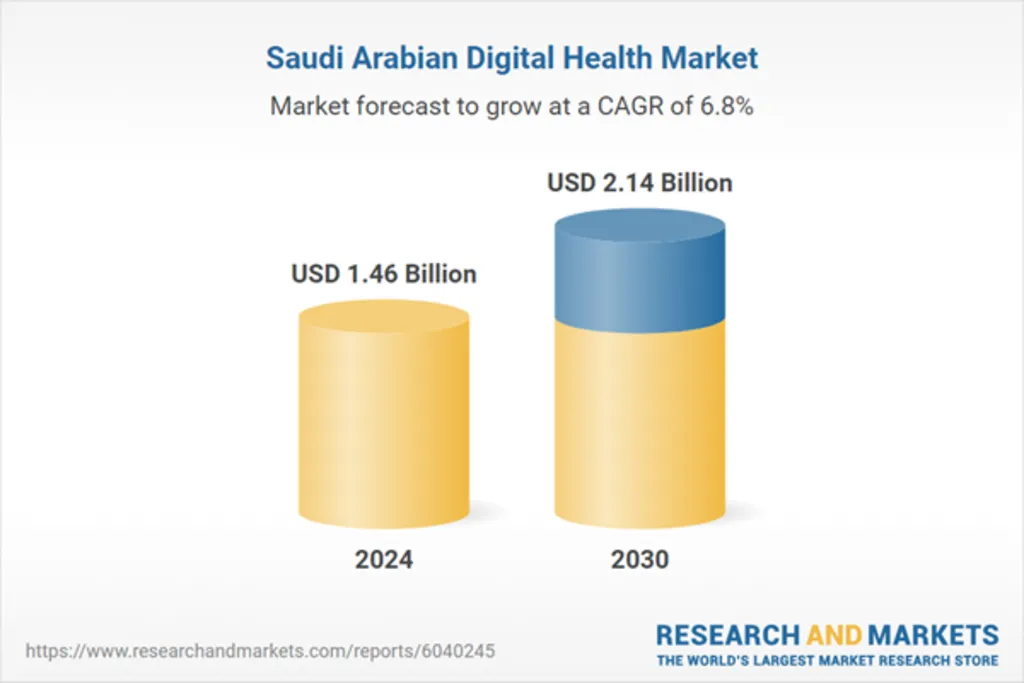Saudi Digital Health Growth to Reach USD 2.14 Billion by 2030
Saudi Arabia’s digital health sector is expected to climb from USD 1.46 billion in 2024 to USD 2.14 billion by 2030, growing at a CAGR of 6.77%. This surge is driven by a convergence of factors: rising chronic disease burdens, rapid technological innovation, and the Kingdom’s strategic push under Vision 2030 to modernize healthcare infrastructure. As digital platforms become central to care delivery, the sector is evolving beyond convenience into a cornerstone of national health resilience.

This article explores the key forces behind Saudi Digital Health Growth, including the role of telemedicine in chronic disease management, the integration of AI and genomics, regional infrastructure leadership, and the groundbreaking virtual health services deployed during the Hajj season. It also addresses challenges such as digital literacy gaps and outlines how personalized medicine is reshaping treatment protocols.
Chronic Disease Management Fuels Digital Health Adoption
The growing prevalence of respiratory diseases—such as asthma and COPD—is a major catalyst for Saudi Digital Health Growth. Environmental factors like air pollution and smoking have intensified the burden of chronic conditions, prompting healthcare providers to adopt remote monitoring and telemedicine solutions. These technologies allow patients to receive continuous care without frequent hospital visits, especially in underserved regions. Smart inhalers, mobile spirometers, and mHealth apps are now integral to managing symptoms and improving adherence to treatment plans.
AI, Wearables, and Mobile Health Drive Innovation
Saudi Arabia’s digital health ecosystem is rapidly integrating Artificial Intelligence (AI) and Machine Learning (ML) to enhance diagnostics, predictive analytics, and clinical decision-making. Mobile health (mHealth) platforms and wearable devices have become essential tools for proactive health management. These technologies empower patients to track vital signs, receive personalized alerts, and engage with healthcare providers in real time. The COVID-19 pandemic accelerated adoption, but the momentum continues as public-private partnerships expand digital infrastructure across the Kingdom.
Digital Literacy Remains a Key Challenge
Despite robust investment, limited digital literacy; particularly among older adults and rural populations, poses a barrier to Saudi Digital Health Growth. Many patients struggle to navigate telemedicine platforms or mobile health apps, reducing their ability to benefit from digital services. Addressing this gap requires targeted education initiatives, simplified user interfaces, and multilingual support to ensure inclusive access to care.
Also Read: Telehealth in Saudi Arabia Set for 25.1% CAGR
Genomics and Personalized Medicine Reshape Care Delivery
The Saudi Genome Program, launched in 2018, is a national initiative aimed at decoding the genetic blueprint of Saudi society. By sequencing over 100,000 genomes, the program enables personalized medicine that tailors treatments to individual genetic profiles. This approach is revolutionizing care for conditions like cancer, cardiovascular disease, and rare genetic disorders. It also reduces healthcare costs by minimizing ineffective treatments and improving early diagnosis. As genomic data becomes more integrated into clinical workflows, Saudi Digital Health Growth is increasingly defined by precision and personalization.
Regional Leadership Anchored in Central and Northern Saudi Arabia
Central Saudi Arabia, particularly Riyadh, leads the digital health charge with concentrated policy initiatives, investment hubs, and healthcare facilities. The region’s dominance is reinforced by its role in piloting new technologies and scaling digital platforms. Northern Saudi Arabia also contributes significantly, with expanding infrastructure and adoption of smart healthcare systems.
Pilgrim Healthcare Innovation: Seha Virtual Hospital and Sehhaty
During the 1446 AH Hajj season, Saudi Arabia showcased its digital health capabilities through Seha Virtual Hospital and the Sehhaty platform. These services provided 24/7 medical consultations in seven languages, including Arabic, English, French, Turkish, Persian, Urdu, and Indonesian. Pilgrims accessed care via audio, video, or text, uploaded medical reports, and received electronic prescriptions—all without visiting a clinic. The “Consult Plus” service enabled field teams to receive expert guidance instantly, improving decision-making and care quality. Supported by over 300 health facilities across Makkah and Madinah, this initiative exemplifies how Saudi Digital Health Growth is not only scalable but also culturally and logistically adaptive.
Also Read: Digital Health Spurs Insurance Growth in KSA







